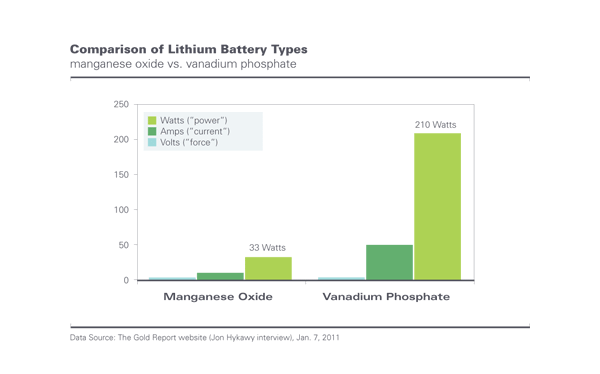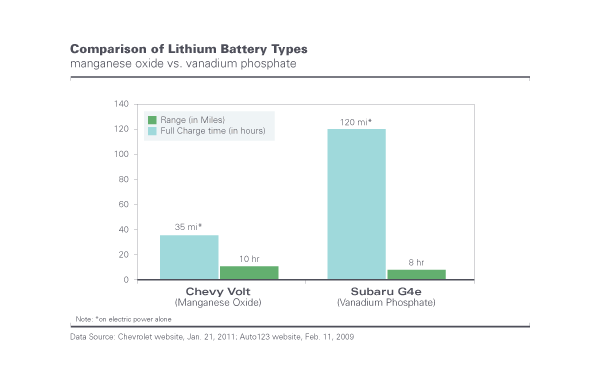RE:RE:RE:Lithium is done going upIf zinc and Manganese workout well.
There is nothing wrong with Vanadium and Lithium Batteries.
But these technologies won't last long enough.
Both topics have been researched but not enough evidence has been gather to be conclusive. But the world is going toward tonnage of lithium and both China and U.S( Tesla, Faraday and Apple) wants Lithium,
As battery technology continues to improve, the lithium-vanadium phosphate batterycontinues to impress multiple commercial markets.
In particular, lithium-vanadium phosphate batteries represent one of the most promising battery solutions in the automotive industry with high enough energy density to convince consumers that electric vehicles can compete with gas vehicles on a performance basis.
With greater safety than the batteries found in cell phones and laptops, and greater power than the batteries found in the latest electric vehicles, these next generation batteries outshine their competition thanks to the critical element: vanadium.
Commercial work on lithium-vanadium phosphate batteries ranges from international battery manufacturers developing various models, to electric vehicle applications, and even rechargeable button-sized versions currently available for backup support.
While this strategic technology is still considered cutting edge, industry analysts already foresee a significant opportunity for increased vanadium demand on top of the growing conventional demand from the recovering steel industry.1
Lithium-Vanadium Battery Advantages
Lithium-vanadium batteries mean improved safety and greater power. That was the message Jon Hykawy, Ph.D., MBA delivered at the Forbes & Manhattan Conference in Q4 2010.
As the head of global research at Byron Capital Markets, Hykawy points to "much improved safety" compared to the lithium-cobalt batteries found in portable electronics.2
And when compared with the lithium manganese-oxide batteries found in the latest electric vehicles such as Chevy's Volt, power – arguably the most important factor in a vehicle application – is 6 times greater when using vanadium in the cathode.1

Battery Makers, Investments & JVs
Major battery manufacturers such as America's Valence Technology Inc. and China's BYD Company Ltd. are among the companies actively doing commercial work on lithium-vanadium batteries.1
In the case of BYD – which is 10% owned by Warren Buffett's Berkshire Hathaway – the company is conveniently both rechargeable battery maker (the largest in China as of mid-2009)3 and auto manufacturer. In Q4 2010, Buffet visited the automaker, which he says will be a leader in electric cars.4
Meanwhile, Japan's GS Yuasa Corporation (GSY) announced at the end of Q3 2010 that it would develop lithium rechargeable batteries using lithium-vanadium phosphate.
A prototype of GSY's lithium-vanadium phosphate battery showed a 20% output gain compared to a lithium iron phosphate battery. GSY indicated further benefits include improved safety and lower production costs.5
GSY expects the new battery to be used in hybrid electric vehicles, a market they already have ample access to via joint ventures with Mitsubishi Motors and Honda Motor Co., and through one of their principle shareholders: Toyota Motor Corporation.6
Extended Range & Shorter Charge Times
When Subaru chose a lithium-vanadium battery for its prototype G4e all-electric vehicle (EV), they were able to significantly increase the car's range while doubling that of their previous advanced EV.7
With a range of 120 miles (200 km),8 the G4e's range far surpasses that of the Chevy Volt's 35 miles (56 km) on electric power alone.
In addition, lithium-vanadium batteries can be recharged faster: 10 hours for the Chevy Volt9versus 8 hours for the G4e (and only 15 minutes for an 80% quick charge).8

Large & Small-Scale Battery Markets
Other emerging lithium-vanadium battery markets include the very large and the very small. On the large end of the scale, many power utilities are looking to use lithium batteries as cost-effective power backup systems for substations during peak demand periods.1
On the opposite end of the scale are Panasonic's button-sized vanadium pentoxide rechargeable lithium batteries. Panasonic sells these compact, high-energy 'secondary' batteries for such backup applications as in phones, personal computers, video cameras and memory cards.
The tiny batteries come with many advantages: nearly twice the energy of conventional button-shaped Ni-Cd batteries; self-discharge rate of <2% a year; months of continuous use as a backup; and superior reliability due to withstanding overcharging and discharging.10
Vanadium Demand Impact
As lithium-vanadium battery applications continue to emerge in the automotive, utilities and electronics industries, new demand for vanadium will also emerge.
According to a Q4 2009 report by Byron Capital Markets, new market demand for vanadium is projected to combine with conventional demand (primarily from the steel industry), resulting in an overall demand increase of over 70% between 2009's levels and those of 2014.2